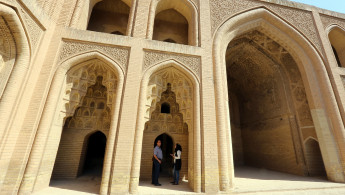Nimrud, jewel of ancient Iraq
Built in the 13th century BC, the city on the Tigris river about 30 kilometres [18 miles] southeast of Mosul once served as capital of the Assyrian empire.
But in April last year, the Islamic State group released a video of its fighters destroying monuments there before planting explosives around the site and blowing it up.
In the video, militants with sledgehammers and power tools broke artefacts before rigging the site with large barrels of what appeared to be explosives.
The subsequent footage showed a massive explosion and its aftermath, suggesting the ruins of Nimrud were largely levelled.
"Whenever we are able... to remove the signs of idolatry and spread monotheism, we will do it," one militant said at the end of the video.
The damage came a week after a video was released in which IS militants wielding sledgehammers were seen gleefully smashing statues in the Mosul museum.
Many of the artefacts destroyed in the video came from Nimrud.
The destruction was part of a campaign of annihilation against heritage sites under militants control that also targeted UNESCO world heritage sites Hatra in Iraq and Palmyra in neighbouring Syria.
 |
| The ancient monuments of Nimrud are seen as idols that violate the teachings of Islamic State's extreme form of Sunni Islam [Getty] |
IS says the ancient monuments are idols that violate the teachings of its extreme form of Sunni Islam, but still sells allegedly forbidden artefacts to fund its operations.
Nimrud, founded in the 13th century BC, is one of the most famous archaeological sites in a country often described as the cradle of civilisation.
Surrounded by a huge defensive mud brick wall, it flourished during the reign of the King Ashurnasirpal in the 9th century BC.
Its vast palaces and monuments have drawn archaeologists for more than 150 years.
The ancient city was first described in 1820 and plundered by Western explorers and officials over subsequent decades.
British crime writer Agatha Christie stayed there with her archaeologist husband and wrote several books.
Most of Nimrud's priceless artefacts were moved long ago to museums in Mosul, Baghdad, Paris, London and elsewhere.
It was also looted and damaged during the 2003 US-led invasion.
But giant "lamassu" statues – winged bulls and lions with human heads – and reliefs were still on site at the time of the IS destruction.
In 1988, archaeologists at the site unearthed a collection of 613 precious stones, gold jewels and various ornaments.
Experts described the "treasure of Nimrud" as the most significant discovery since Tutankhamun's tomb in Egypt in 1923.
The treasure, which dates back to the Assyrian empire's heyday around 2,800 years ago, was briefly displayed at the National Museum in Baghdad before Iraq invaded Kuwait.
It was then hidden and its fate remained unknown until it was discovered in 2003, soon after US-led troops toppled Saddam Hussein's regime, in a bombed out central bank building.



